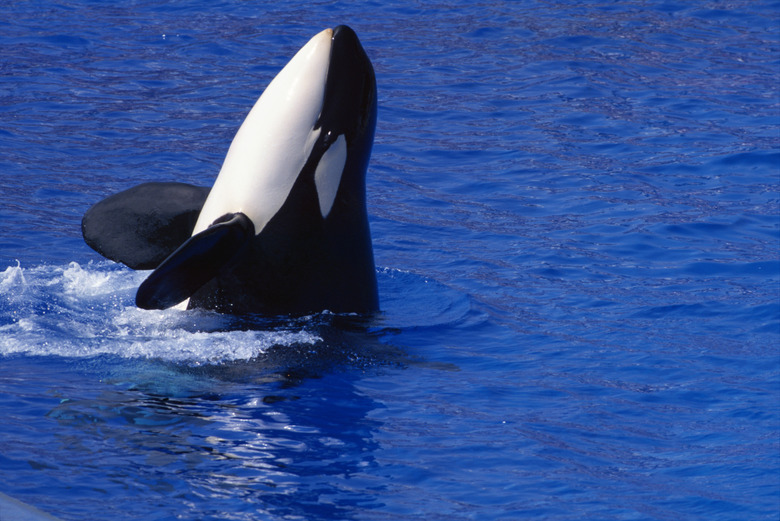The Ecosystem Of Killer Whales
The Congressional Research Center defines an ecosystem as a "community of organisms interacting with each other, and with the chemical and physical elements making up their environment." This means an ecosystem can be a garden pond or a tropical ocean. Dolphins-World.com says the killer whale is found in more than one type of ecosystem and, after humans, it is the most widely distributed species on the planet.
Ecosystem Distribution
Ecosystem Distribution
Killer whales are found in all the world's oceans. Although they are found in open seas, the whales tend to prefer congregating in coastal waters. The Arctic and Antarctic oceans have the biggest concentration of killer whales because they prefer colder waters. However, they sometimes venture into warmer waters and may be seen in the Gulf of Mexico, and off the coasts of Australia and Hawaii. Occasionally killer whales have turned up in fresh water rivers.
Food
Food
One of the reasons killer whales prefer the cold waters of the Arctic and Antarctic is that these ecosystems have more abundant food supplies. These whales are the ocean's top predators and they like a diet of fish, ranging from salmon to halibut, cod and herring, and other marine mammals, such as seals, if the opportunity arises. An ecosystem dictates what the whales may eat, and these mammals take whatever is available. This dietary adaptation to various ecosystems is the reason whales survive in diverse regions.
Antarctic Whales
Antarctic Whales
In the Antarctic ecosystem, there are three identifiable types of killer whale, each with its own dietary habits. The Type A whale feeds almost exclusively on minke whales, while the Type B whale prefers a diet of seals, but will also hunt minke and humpback whales if necessary. The Type C whale only eats the Antarctic toothfish. Killer whales also use the environment as part of hunting techniques. In Antarctica a whale may push up on to an ice floe and slide over it to catch a penguin. They are also known to bump into ice floes and knock prey off into the water.
North Pacific Ocean
North Pacific Ocean
Waters off the western coasts of the U.S. and Canada are a breeding and feeding ground for both resident and transient killer whales. Here, resident whales spend about two-thirds of daylight hours foraging for food. They mostly eat salmon and don't touch the other marine mammals in the area. The nonresident killer whales on the other hand tend to hunt all day for marine mammals, such as seals, sea lions and other whales, and don't eat any fish. As a result, the two groups of whales never come into conflict over food resources.
Cite This Article
MLA
McKenzie, Eleanor. "The Ecosystem Of Killer Whales" sciencing.com, https://www.sciencing.com/ecosystem-killer-whales-8782343/. 24 April 2017.
APA
McKenzie, Eleanor. (2017, April 24). The Ecosystem Of Killer Whales. sciencing.com. Retrieved from https://www.sciencing.com/ecosystem-killer-whales-8782343/
Chicago
McKenzie, Eleanor. The Ecosystem Of Killer Whales last modified August 30, 2022. https://www.sciencing.com/ecosystem-killer-whales-8782343/
